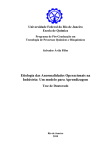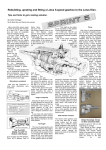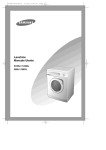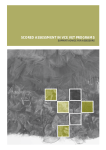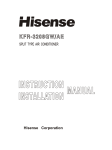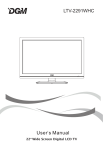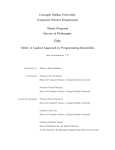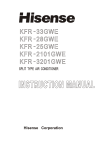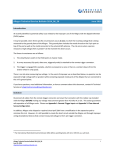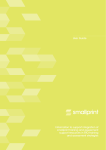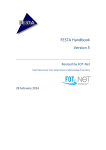Download Human factors that influence the performance of the
Transcript
The Role of Telecare in Older People’s Daily Lives: experiences, practices and attitudes Working Papers from the AKTIVE project 2011-2014 AKTIVE Working Paper 5 Lifestyles in Later Life: identity, choice and stigma Kate Hamblin Oxford Institute of Population Ageing University of Oxford Human factors that influence the performance of the telecare system Published by CIRCLE, University of Leeds, April 2014 ©University of Leeds, University of Oxford and the author ISBN 978-0-9928741-6-2 Online version: http://www.aktive.org.uk/ Also available from: CIRCLE Centre for International Research on Care, Labour and Equalities University of Leeds, Leeds, LS2 9JT, UK Tel: (+44) 113 343 4872 Web: http://www.sociology.leeds.ac.uk/circle Email: [email protected] Acknowledgements Research, analysis and development of the working paper Data discussed in this paper were collected and analysed by the author and researchers responsible for the AKTIVE fieldwork: Kate Hamblin and Emanuela Bianchera (University of Oxford) and Emma-Reetta Koivunen and Gary Fry (University of Leeds). With Sue Yeandle (who directed the AKTIVE project and edited the AKTIVE working papers), these colleagues also advised on the content and development of this paper. The author gratefully acknowledges their contributions. Research participants The research team is extremely grateful for the contribution made to the study by the older people who took part, sometimes in difficult circumstances, who allowed us into their homes, gave generous and thoughtful interviews, permitted us to observe their living situation and assisted us by completing diaries, taking photographs and in other ways helping us gain a full picture of their everyday lives. We also wish to thank their family members, home care workers and others involved in their care who agreed to be interviewed or observed or who completed questionnaires. These contributions were vital to the study, which would not otherwise have been possible. To protect the confidentiality and privacy of those who took part, all names, and some identifiable details, have been changed. Funding of the AKTIVE project The main funding for AKTIVE was provided by the Technology Strategy Board (TSB), which developed the scheme through which the project was funded in collaboration with the Economic and Social Research Council (ESRC) and the National Institute for Health Research (NIHR). AKTIVE industrial partners Tunstall Healthcare (UK) Ltd and Inventya Ltd also contributed resources to the project. AKTIVE was originally funded under the name ‘The Potential of Assisted Living Technologies for Older People at Home: creating a knowledge base for businesses developing technology for dementia and falls’, contract reference number 400215 / 2592-25185. Human factors that influence the performance of the telecare system 1 Introduction The AKTIVE research study has afforded a unique opportunity to study how frail older people and those who support or care for them are interacting with today’s telecare systems. Those studied include not just the 'end users' of the telecare service, but also the care support groupwhich may be involved with them (e.g. relatives, friends, neighbours), those working in monitoring and response centres, assessors and reviewers of end-user requirements and even those who install and maintain the equipment and services. The in-depth nature of the study has enabled the social dimensions of the system to be observed and explored providing rich, in-depth data that has not before been gathered. These data form the basis for this working paper on the human factors that influence the performance of the system, where difficulties or failures have or could occur and how improvements might be made. Telecare may be considered as an example of a complex socio-technical system. The human factors aspects of socio-technical systems have been extensively studied the past and, more recently, in a number of healthcare scenarios (Buckle, 2012; Carayon et al, 2006; Hignett et al, 2013). However, there is little evidence that this approach has previously been undertaken to investigate performance and failure issues with respect to telecare services. We have presented here the research component of the study that investigated where and how telecare systems might fail, generate errors or under-perform. Undertaking such analyses is standard practice in many industrial socio-technical systems. They are all based on an understanding of factors that influence human performance and the likelihood of human error (Reason, 1990; Rasmussen et al., 1994). In many industries (HSE, 1999), and particularly in the health sector (Ward et al., 2010a), they have proved immensely helpful both in reducing the likelihood of errors (notably human errors) and in enhancing the performance and quality of the system. This is because the methods used often indicate where improvements to the design of the system may be beneficial in optimising human performance. These design improvements are not limited to the physical elements of the system (e.g. in the case of telecare the pendant alarm or bed detector) but may also address shortcomings in the design and flow of information, training programmes and even the design of the service itself. During the AKTIVE project we have also considered the idea of individual risk and freedom afforded by telecare from a number of perspectives (Yeandle, 2014a; Hamblin, 2014). The context and findings presented in Hamblin's paper provide a useful context within which failure of technologies, human error and design limitations may be understood. This element of the study has used human factors (also known as ergonomics) approaches to identify risks (Wilson and Corlett, 2005; Stanton et al., 2005). We do not believe this approach has been used in this manner with telecare previously, and thus the research was 'ground breaking'. 1 Human factors that influence the performance of the telecare system 2 Methods The approaches used to research these elements of the system have been described elsewhere (Yeandle et al.,2014b) and only the findings are reported here. However, it is worth re-iterating that this component of the research set out with the intention of using Prospective Hazard Analysis (PHA) approaches. These are standard practice in many high hazard industries, including chemical engineering, aerospace and nuclear power generation. They allow a predictive and proactive approach and thereby offer potential for identifying problems in existing systems and, more importantly, opportunities for improving them. Increasingly these methods are also being used in health care, particularly for patient safety risk assessment (Ward et al.,2010b). PHA is especially useful in developing systematic thinking regarding the identification of risk and the development of improved design of systems. Previously, PHA had seen only limited use in technology and health / social care situations. The application of these methods through the AKTIVE research study was therefore novel. PHA is not a single method, but rather an approach and a range of tools (Ward et al., 2010) that form a systemic, systematic and structured process to support the identification of hazards, their potential consequences and hence risk. The methods draw both upon existing system performance and failure data and on subjective sources of risk information obtained from those that have experience of the system(s) being assessed. The following steps are usually considered necessary to undertake PHA: 1. Describe the socio-technical system 2. Generate a process description 3. Identify hazards prospectively – i.e. where is the potential harm; where might the system fail? 4. Analyse, prioritise and / or quantify the risk arising from the hazards 5. Recommend mitigation and risk reduction or hazard elimination strategies Assessing the telecare system from this ergonomics / human factors perspective has involved extensive system mapping (Buckle et al., 2010) stakeholder identification through workshops, observational work by the research team and drawing on the ELA data and analyses. However, the complexity of the system only became apparent on completing step 1 (i.e. describing and mapping the system). This complexitymeant that it has not proved possible to complete all of the steps for a full PHA. Nevertheless, a substantive body of results has been compiled and analysed that addresses the first three aspects and enables recommendations to be made for mitigation and risk reduction or for hazard elimination strategies. It has not been possible to quantify the risk, as the data required were not readily available. 2 Human factors that influence the performance of the telecare system 3 Managing risk The map of those engaging with the development and delivery of telecare is complex. Figure 7.1 represents the key components we identified from a combined set of workshop inputs within Oxfordshire and Leeds (the two study locations). It is probable that additional variations exist in other localities. Figure 7.1 Map of those engaged with the development and delivery of telecare The workshop mapping exercises demonstrated the complexity of the system that currently exists for both the development and delivery of telecare. This map was compiled during a series of workshops covering a wide range of interest groups, including those working on other TSB ALIP research studies (Yeandle et al., 2014). Mapping proved to be a powerful tool in understanding the system, contextualising the research and interpreting the findings. It is recommended that this approach to researching complex care and health systems is used more regularly, as it is both simple to undertake and engages with a wide number of stakeholder groups, allowing easy access to their experiences, successes and failures (Buckle et al., 2010). The system complexity presents both opportunities and challenges. For example, the information held within this system is immense and potentially vital to improve the quality or performance of telecare. 3 Human factors that influence the performance of the telecare system Identifying those with this information and establishing the nature and content of this information proved complex, however, and beyond the scope of the study. What has emerged is a complex picture involving many stakeholders for whom little has previously been documented on their needs, abilities or wants. The implications of this have been that, too often, important information is held by one stakeholder that could help others, but this is either not recognised or not appreciated. Call centres, for example, have records of calls from telecare users that might, through increased frequency or the nature of the call(s), be an important indicator of the changing physical or mental state of the user involved. This information could be of great use to those who are in a position to investigate the reason for this change. In particular, it is recognised that changes in medication can lead to behavioural or physical changes. Early intervention following 'warning signs' such as increased false alarms to the monitoring centres could promote a proactive investigative response, rather than waiting until a response of a more serious nature is required (e.g. following a fall). Mapping the information held in this complex network is a further important piece of research that fell outside the scope of the AKTIVE project; suitable methods exist, however, and have been applied successfully in areas of healthcare (Nagpal et al., 2012). A simplified map has been prepared (Figure 7.2) that identifies the key stages in the process of telecare provision. This graphic representation of the process has been used to help categorise and present our findings on both the potential for failure and / or on errors that occur within the telecaresystem. Jun et al. (2009) have provided an authoritative review of how such process maps can benefit our understanding of health care, and it is important to recognise that they can and should be used in health and social care scenarios such as telecare provision. Figure 7.2 4 Simplified process map of telecare provision Human factors that influence the performance of the telecare system 4 Discussion: Independence, control and risk management - a balancing act Performance Difficulties, Errors and Failures Problems that result in potential failures within the current telecare system can occur through procurement, assessment of client needs, installation of equipment, review of equipment, client use, at monitoring centres and even in response settings. While it has been difficult to quantify or even prioritise the scale of these failings, it is nevertheless apparent that significant problems exist. These problems have frequently emerged in discussion with stakeholders throughout the system, and in particular through the ELA. The data arising from the ELA provide a rich set of insights into the challenges facing those providing telecare services. Tables 7.1 to 7.7 illustrate the concerns identified from the social research team’s work with telecare users and those who care for or support them. They have provided a great deal of evidence to support the need to improve a number of components of this socio-technical care system. They have also helped establish that solutions can only be found through co-operative participative design consultation if the true needs of end users are to be met. Table 7.1 Physical Equipment Design Issues Example 1: Battery design Interviewer: So when the battery actually expires, you can’t use the system at all? Mr Lindsay: No, no. No, but you don’t have any indication. Interviewer: There’s no like beep? What’s this? Mr Lindsay: No there’s no beep or anything. You just – you just press it and there’s nowt there (laughs). You know, that’s basically it. Interviewer: Yeah. So really, if it’s attached to your belt and you’re not looking at it, you – it could actually expire without you knowing it. Mr Lindsay, 65, memory problems, living with wife, Leeds, GPS device user Example 2: Comfort Interviewer: So are you still wearing it on your wrist every day? Mrs Barnard: Yes, I do. I have been taking it off occasionally because it was beginning to – yes— Interviewer: Itch? Mrs Barnard: Yes, it was really. It was beginning to get— Interviewer: Is that when it's warm outside, is that when it's warm? Mrs Barnard: I think it's just when it's on, it's on for a long time, so I think that I'm better to take it off a few times. Mrs Barnard, 89, memory problems, living alone, Leeds, user of telecare package. 5 Human factors that influence the performance of the telecare system Example 3: Difficult to put on Mr Hodgkins it’s not easy to put on, because - it may be my slight trembling - but the difficulty is getting the strap threaded through and trying to control it at the same time. So I’ve found the only way I can do that is to lay it on the bed and put the strap on and try and adjust it and get it through. It’s getting it through the metal clasp initially. Interviewer: Oh, so it’s like a wristwatch type? Mr Hodgkins: Yes, if I show you…. Like that, right - now that will be at the side of my bed and I will pick it up and then I will have to lay it like that on the bed and then the difficulty is to get that strap through there. Mr Hodgkins, 70, memory problems, living alone Leeds, user of telecare package. Example 4: Inconvenience I don’t wear it overnight because if it sets up the call system, it would take me ages to get downstairs, even with the lift, to speak to them. Mr Hodgkins, 70, memory problems, living alone, Leeds, user of telecare package. Example 5: Design too limited I’ve got the thing that goes under the bed. That’s presumably in case you falls in the night or whatever. Yeah, I think it is OK, but it’s very difficult to give them a time when you actually – when they say,‘what time do you want it to active?’, particularly in the morning, because I think mine goes off at seven. Well I mean, I’m always awake by then, but what I tend to do is have a cup of tea and go back to bed. So then when I get up about quarter to eight, presumably if I fell then, I would have to activate the alarm, Mrs Wooley, 83, falls, living alone, Leeds, user of telecare package. Size: I’m sure they can make it smaller. There must be a way that they can design it smaller so that it isn’t such a, a bit of an eyesore, not so uncomfortable for them. Do you know where it is actually? Daughter of Mrs Inigo, 76, living with daughter, memory problems, Oxfordshire, former pendant alarm, reminder system and GPS device user Example 6: Design of tablet dispenser Interviewer: And the tablet dispenser works OK and you haven’t got any…? Daughter of Yes, well, other than dad tips it on its side to get the tablets out but then leaves it on its side. And it Mr Carlson: doesn’t like it very much, it likes to be flat.Well because he hasn’t turned it over. It’s designed when you turn it over. He leaves it stood up, so when the tablets come through they just drop out. And then he phones us and tells us that it’s beeping all the time. So then we’ve come over and we’ve checked it, it’s just been he’s not tilted it. Daughter of Mr Carlson, 80, memory problems, living alone Leeds, user of telecare package and GPS device Example 7: Design of timer interface That was just, I couldn’t suss it out to work out the timer on it, and it was just so complicated. Really complicated. So I do think some of the things they’ve got, I just think,‘Gosh’. Daughter of Mrs Inigo, 76, living with daughter, memory problems, Oxfordshire, former pendant alarm, reminder system and GPS device user Source: AKTIVE ELA database, CIRCLE, University of Leeds. 6 Human factors that influence the performance of the telecare system Table 7.2 Fear of use by the end user, resulting from poor design and poor understanding Example 1: Interface design Interviewer: What are these buttons for? The red ones for? Mr Hodgkins: I don't touch them at all, I daren't touch them in case owt goes wrong. So I just leave them as it is. Mr Hodgkins, 70, memory problems, living alone, falls, Leeds, user of telecare package. Example 2: Information provision and design Interviewer: So you can actually request what you need, explain what you need? Mr Hodgkins: Probably would do. When I got that, I didn’t get no literature or anything like that with it. You know, I just got a bit of paper that tells you like, you press and all that, but it didn’t give you no bookletsof what happens, you know. Interviewer: Like a little guide or something? Mr Hodgkins: Yeah. Interviewer: Do you think that'd have been helpful? Mr Hodgkins: I didn’t get nothing like that. Interviewer: Do you think that would have been helpful? Mr Hodgkins: It would have been, yeah, because you know what to do and that lot, yeah. Mr Hodgkins, 70, memory problems, living alone, falls, Leeds, user of telecare package. Example 3: Complexity of use Mr Court: My wife’s got one (medication dispenser) but we’ve no idea where it is - and the reason she won't use it is because it’s, what one would say, technicalities, it’s too technical, too clever. It’s got more than one button. Interviewer: So it’s different, it’s more complex than this one? Mr Court: There’s nothing complicated about it, but it’s just too much for her, she can’t. Interviewer: All right, so you can deal with it, but your wife can’t? Mr Court: She won't even change a programme for the telly ‘cause she might press the wrong button and something might happen. Mr Court, 82, falls, living with wife, Leeds, user of telecare package 7 Human factors that influence the performance of the telecare system Example 4: Lack of crucial knowledge Mr Maveritt: And then as soon as I get out of my bed, I put this on and then I go, wobble, in there and get a quick wash. And many a time I’ve wet it, forgetting. Interviewer: Well, you know, I think it’s waterproof. Mr Maveritt: Is it waterproof? Oh, I didn’t know that. Interviewer: I think so, yeah. Mr Maveritt: Oh, I’ve been terrified. Interviewer: Yeah, I think they’re all waterproof. You can wear them in the shower. Mr Maveritt: Oh, I never knew that. Crikey. Interviewer: Did they not tell you when they brought it? Mr Maveritt: No, I’ve never heard that.Oh well.Mind you, when I think about it, you know, a person can — you do fall in showers and that. Mr Maveritt, 71, falls, living alone, Leeds, user of telecare package. Example 5: Demonstration of how to use equipment (1) Mr Peters: Sorry, we can’t give you more info about the technological gear, but I really do need somebody along to just get me up to speed on it. And I don’t think it, honestly, I don’t think it will be long. I suppose we talked so long about setting it up that when it came to the very quick demonstration. Interviewer: About actually using it? Mr Peters: That was a little bit that I didn’t have to the forefront of the mind. Husband of Mrs Peters, 67, memory problems, Leeds, user of telecare package Example 6: Demonstration of how to use equipment (2) Interviewer: So you were in hospital when they installed the device? Mr Eaves: Yeah. So this one, it's got the little button on it, it's got the little – I don’t know what that thing is, but apparently – I'm not going to test it now, if I press that, somebody will respond. Mr Eaves, 77, falls, living alone, Leeds, user of telecare package Source: AKTIVE ELA database, CIRCLE, University of Leeds. 8 Human factors that influence the performance of the telecare system Table 7.3 False alarms and accidental triggering, leading to inappropriate use Example 1: Size and location of pendant button Interviewer: Does that happen often when it goes off accidentally? Mrs Cooper: Well, it’s the first time with this one, although I think it’s going to be easier to set this one off than the old one. Interviewer: Why is that? Mrs Cooper: Because there’s more of that to press. Interviewer: Oh, more button? Mrs Cooper: Last night it was there and my ashtray was balanced there, and that’s what set it off. Interviewer: But does it make it easier to use when you need it because it’s bigger, or does it make no difference? So actually, the bigger button is more of a problem because it might be set off accidentally? Mrs Cooper: Well, yes. The other one was more indented. This one, you’d only have to touch it, because it’s flatter. Now if I went like (demonstrates) across my arms, I’d probably set it off. So I’ve got to be careful. Interviewer: So the indented one was better? Mrs Cooper: I think so. Mrs Cooper, 68, falls, living alone, Leeds, pendant alarm user Example 2: Ease of accidentally triggering fall detector I’d taken the telecare off, and I’d actually popped it into my trouser pocket - and as I was taking my trousers off, I sort of slung them. Nothing happened, and then all of a sudden I could hear the telephone going down here, so I had to come down to communicate with her to apologise, and to say it was all my own fault. Mr Hodgkins, 70, memory problems, living alone Leeds, user of telecare package Example 3: Need to cancel false alarm From ELA researcher notes: The cord is very loose and she does not know who to call- she asked me which button to press to tell them she needs a new cord. It is clear that if she did press the alarm, she not only would she not know how to cancel it, she also cannot get to it as it is in the front room which she can no longer access. Mrs Richardson, 93, living alone, falls, Oxfordshire, pendant alarm user Example 4: Accidental triggering during sleep, and consequences He has had a false alarm when he was sleeping and pressed button accidentally, so he now does not wear the pendant when he sleeps. He also does not wear the pendant during the day, he says that he as he has the lifeline in the living room, he can press that if anything happens [although if he fell e.g. in kitchen, it wouldn’t work…] Researcher fieldwork notes on Mr Whittaker, 77, falls, living alone, Leeds, user of telecare package 9 Human factors that influence the performance of the telecare system Example 5: Accidental triggering during noisy activities and consequences She recently tested the pendant and it worked well; she also accidently set the fall sensor off while cleaning- because she was hoovering she didn’t hear the call and her daughter came out. But the call centre was able to tell her that it was the fall detector which had gone off, so she knew it was unlikely to be a real emergency as her mother rarely wears it (if it was from the pendant, she would have been more worried). Researcher fieldwork notes on Mrs Robinson, 77, living alone, falls, Oxfordshire, pendant and fall detector user Source: AKTIVE ELA database, CIRCLE, University of Leeds. Table 7.4 Design of reminders and alarm checking Example 1: Sound of alarms In fact, I think that’s one of the things I’m very remiss about. I don’t check in as I should do. I don’t like it, because I don’t like the loudness of it, you know? When you – there’s sort of something about alarms and things that go off that, you know, they’re a bit disturbing because you wonder if you’re going to be able to switch them off, kind of thing. Mrs Wooley, 83, falls, living alone, Leeds, user of telecare package Example 2: Medication reminder system She also had a medication reminder system but it ‘drove her crazy’ as she couldn’t shut it off. Mrs I’s daughter said it was overly complicated, and she also struggled to understand how to adjust it. Researcher fieldwork notes on Mrs Inigo, 76, living with daughter, memory problems, Oxfordshire, former pendant alarm, reminder system and GPS device user Example 3: Pendant Mrs Inigo likes the pendant alarm but did not like the reminder system as she could not remember how to shut it off once she had taken her medication. Researcher fieldwork notes on Mrs Inigo, 76, living with daughter, memory problems, Oxfordshire, former pendant alarm, reminder system and GPS device user Source: AKTIVE ELA database, CIRCLE, University of Leeds. Table 7.5 Design ideas arising from telecare users Example 1: More communication stations It’s probably [too impossible a] technical thing to do. I’m not sure. But I do think it would be good if you could talk into the hand thing as well, because, obviously, if she’s downstairs, maybe even in the kitchen, she can talk, you know. If the problem – if she was in the kitchen, she could still talk to them. But upstairs, obviously there’s no way of actually communicating with them. Great-niece of Miss Chester, 89, falls, living alone, Leeds, user of telecare package 10 Human factors that influence the performance of the telecare system Example 2: Alarm cancelation when away from communication box in garden Miss Chester’s great-niece: Again, that’s the thing. If you had a false alarm in the garden, telecare people would contact you. But, it being here, you wouldn’t hear it. So then it would raise all the emergencies again. Interviewer: It would raise, yes. Miss Chester: It’s difficult that, because, I mean, the three of my falls have been in the garden. Miss Chester’s great-niece: Well, yes. So in that case, it’d be good because then we would get somebody out to you. But that’s why I just think it would be good if you could, you know – even if you just heard something, whether it just be a beep or something, that then you could cancel – you can push a button, sort of thing, to say, ‘Oh no, cancel that. I don’t need it.’ Miss Chester, 89, falls, living alone, Leeds, user of telecare package Example 3: Alarm cancellation when away from communication box in house There are issues around false alarms. Daughter says this is because her mother cannot hear it, but mother says it is because she cannot get to the alarm box in time (it is in the front room where the telephone point is. Very hard to get to quickly. Lots of furniture to navigate!) The location of the box is a big problem – cannot get to it quickly enough to cancel. However, daughter’s account is that she can’t hear it to know she’s accidently activated it. Daughter: That’s right, yes, because my cousin said to me, ‘You should get that relocated’ but I don’t think they could relocate it. Researcher fieldwork notes on Mrs Richardson, 93, living alone, falls, Oxfordshire, pendant alarm user Source: AKTIVE ELA database, CIRCLE, University of Leeds. Table 7.6 Links to monitoring centre Example 1: Updating information Mrs W has had two questionnaires about the telecare service- a customer satisfaction questionnaire and a client update form. She has found none of the questions to be relevant. In terms of liaising with the service provider, Mrs W called up once to change the name of a contact and they said it was very difficult. Researcher fieldwork notes on Mrs White, 78, falls, living alone, Oxfordshire, pendant alarm user Example 2: Need to communicate directly with telecare user Because how can they respond to me? I mean clearly it has the advantage it will be where I am. They would have to telephone [carer’s name], that's the only thing they can do. But if they don't have a conversation with me, they don't know whether I've broken a bone or what I've done, so in fact an alarm without something that they can reply to doesn't really do the job. It's not sufficient to say help, and then not be contactable, as help with the phone you see. You see in that situation, now let's suppose that these two hadn't been turning up, I would have got into here without anybody here. I might have got to the phone and rang up [carer’s name]. But really, if I can't respond to the box and tell them why I've pressed it, they've got to send somebody out. Mr Watson, 87, falls, living alone, Oxfordshire, pendant alarm user 11 Human factors that influence the performance of the telecare system Example 3: Feedback on Bed sensor that could be more helpful But the lack of communication from the response centre is proving challenging. Unless the response team go out, the family had no idea the bed sensor was going off as much as it was. Mrs Ramsey’s memory problems mean she cannot remember it has happened to tell them. Researcher fieldwork notes on Mrs Ramsey, 96, falls and memory problems, living alone, Oxfordshire, user of telecare package Source: AKTIVE ELA database, CIRCLE, University of Leeds. Table 7.7 Problem of design for those with other impairments Example 1: Hearing ability (1) As she is deaf, she cannot hear the telecare box and though she has a hearing dog,…. Mrs Robinson, 77, living alone, falls, Oxfordshire, pendant and fall detector user Example 2: Physical strength The only thing I've worried a little bit about, because she is so frail now, and not much strength in the fingers, is if she had to push the button, would she have the strength to do it? That's a concern. Daughter of Mrs O’Carroll, 86, both falls and memory problems, living alone, Oxfordshire, user of telecare package Physical condition: actually physically put it [wrist-worn pendant] on, it’s not easy to put on because it may be my slight trembling but the difficulty is getting the strap threaded through and trying to control it at the same time, so I’ve found the only way I can do that is to lay it on the bed and put the strap on and try and adjust it and get it through. Mr Hodgkins, 70, memory problems, living alone Leeds, user of telecare package. Vision: But, you know, when you get these documents, I mean it was about a three-page document, they always do say, ‘If you want any help, ring’" But it must be very hard. For people who can’t follow them or haven't anybody to turn to, to process them really. ….. And the other thing, at the weekend I had two friends who are partially sighted with me, and they both had all these documents that needed – and I spent my time going through the documents. And I thought how difficult for them it was. And by the time you’ve requested it in large print, which I mean we’re very good at in this country, often the appointment’s come and gone, you know, by the time it arrives. Mrs Woolley, 83, falls, living alone, Leeds, user of telecare package Example 3: Hearing ability (2) Mrs Robinson is deaf and called me to say she’d been having problems with her Ivi pendant which was part of her upgrade. She said she must keep accidently pressing it because it keeps going off- I explained that as it has a falls detector inside it, she might be accidently setting it off if it swings around or is knocked. She said she would be more careful with it but I received an email from her daughter saying the problem persisted and her mother was put of wearing it at all. Researcher fieldwork notes on Mrs Robinson, 77, living alone, falls, Oxfordshire, pendant and fall detector user Source: AKTIVE ELA database, CIRCLE, University of Leeds. 12 Human factors that influence the performance of the telecare system Addressing these problems has been an important challenge in this study. The following section considers the challenges that emerge from the data collected and how solutions may be found or generated. A series of tables (Tables 7.8 to 7.14) show where such failures occur, considerations as to why such failures occur, and possible remedies or solutions to these problems. Each element of the process map of telecare has been considered separately but it is recognised that errors or problems arising in one part of the process may only become apparent further along the process line. For example, a faulty assessment of the capability of the end user may lead to the provision of a device that cannot be operated. This may appear as an ‘enduser’ problem but an important root cause of this failure had occurred much earlier in the process where there had been a failure to train the assessor correctly. Table 7.8 Procurement difficulties Performance difficulties, errors, failures Why would this happen? What might the solutions be? Better training for procurers. Lack of appropriate manufacturer information Manufacturer’s information designed to better match the user’s abilities/needs and the specification of the equipment. Improved interactive websites for accessing and selecting equipment. ‘Trip advisor’ style website, enabling comments and feedback to be readily posted. Better training Inappropriate equipment purchased Lack of appropriate knowledge within purchasing team Manufacturer’s information designed to better match the user’s abilities / needs and the specification of the equipment. Improved, interactive websites for accessing and selecting equipment. ‘Trip advisor’ style website enabling the posting of comments and feedback Complex interoperability issues Review of, and adherence to, standards. Too long time delays between purchasing decisions relative to change in technology Speedier decision making (as part of commissioning brief). Source: AKTIVE ELA database, CIRCLE, University of Leeds. 13 Human factors that influence the performance of the telecare system Table 7.9 Assessment difficulties Performance difficulties, errors, failures Why would this happen? What might the solutions be? Training needs to be standardised and reviewed. Not trained adequately. Trainers need to be given professional support. Trainers need to help assessors understand interoperability issues. Training and awareness of broader product range limited. Training out of date. Recommends inappropriate equipment Did not have access to relevant information Competency in training to be recognised and assessed. Manufacturer’s information designed to better match the user’s abilities / needs and the specification of the equipment. Interactive websites for assessors to use to improve their abilities for selecting equipment. Better information and training for assessors. Equipment provided did not fully meet the needs of the end users. Provision of equipment needs regular reviewas changes in circumstances / context of use are frequent. Better feedback of the problems and issues encountered to designers and managers Charging arrangements Recommends inadequate mean some clients cannot or non-optimal equipment have additional / appropriate sensors. Improved understanding to help with commissioning process. Source: AKTIVE ELA database, CIRCLE, University of Leeds. 14 Human factors that influence the performance of the telecare system Table 7.10 Installation Difficulties Performance difficulties, errors, failures Why would this happen? What might the solutions be? Technical faults in system Checklist for ensuring that technical faults are not overlooked Installer not trained adequately Basic training for installers is required, with a certificate of competency. The quality of the documentation should be designed inclusively. Incorrectly installed Deficiencies in design and operating documentation. Those with visual impairments need to be considered. Experts in inclusive design (e.g. equipment, instructions) should be consulted. Basic training for installers is required with a certificate of competency. Fail to check user can operate equipment Installer not trained adequately Fails to check electrical integrity of equipment Installer not trained adequately Basic training for installers is required with a certificate of competency. Fails to train user/carer appropriately Installer not trained adequately Basic training for installers is required with a certificate of competency. Fails to train user/carer appropriately (care home) Installer not trained adequately Basic training for installers is required with a certificate of competency. Fails to check that training in understood and users compliant Installer not trained adequately Basic training for installers is required with a certificate of competency. Training instructions and information for clients to be clear and simple. Manufacturer procedures (if new) Note: this aspect not explored in this research but should be assessed by service providers and appropriate checks (if not already in place) put in place to prevent errors. Installers / service engineers do not check equipment if reconditioned Note: this aspect not explored in this research but should be assessed by service providers and appropriate checks (if not already in place) put in place to prevent errors. Faulty equipment 15 Equipment check to ensure that users can operate the equipment in an appropriate and timely fashion. Human factors that influence the performance of the telecare system Cannot be installed Installation of ‘complex’ equipment (e.g, fixing to walls or ceilings) requires a referral to an engineer Need for training closely aligned to the assessment and the context into which the equipment is to be installed. Better environmental assessments of what is feasible and / or practical in each setting. Source: AKTIVE ELA database, CIRCLE, University of Leeds. Table 7.11 Problems relating to the review process Performance difficulties, errors, failures Review not timely Review not completed Why would this happen? Lack of information re when review is needed What might the solutions be? The review system needs to be improved and perhaps standardised. Monitoring centres could lead in initiating a review based on client demands and behaviours. Lack of resources Routine reviews maybe a more effective approach to avoiding untimely events. Lack of resources Routine reviews maybe a more effective approach to avoiding untimely events. Database enhancement at the monitoring centres may help avoid missed reviews. Review not completed Client in hospital May require additional information on the client being made available to the monitoring centre. Source: AKTIVE ELA database, CIRCLE, University of Leeds. Table 7.12 Problems arising with client use Performance difficulties, errors, failures Why would this happen? Not appropriately designed Industry should work more closely with inclusive designers, human factors experts and human computer interface specialists. Not user tested Installers and assessors must ensure that the end users can both operate equipment and fully understand what it is achieving. Cannot use equipment 16 What might the solutions be? Human factors that influence the performance of the telecare system Not appropriately assessed Installers and assessors must be aware that the technology may not be fully inclusive of all intended users. Ensuring that the users can operate it before it is left with is essential. Deficiencies in design and operating documentation (only verbal instructions and/or a poorly designed user manual) Cannot use equipment (cont.) The industry / manufacturers should work more closely with inclusive designers, human factors experts and HCI specialists. Identify good examples of inclusive instruction manuals Installers and assessors must be aware that the technology may not be fully inclusive of all intended users. Fail to check user can operate equipment and / or that training / instructions given are understood / users are compliant Ensuring that the users can operate it before it is left with is essential (e.g. location of the base unit may result sin user being unable to hear or respond to the alarms). The need for a more resilient system, perhaps with additional sound units should be explored. Equipment requires maintenance, e.g. carbon monoxide detector batteries Maintenance procedures did not form part of this study but should be reviewed and their potential to include maintenance of ‘user knowledge’ as well as equipment should be considered. Need to overcome fears and suspicion regarding telecare equipment. Fear, stubbornness, lack of understanding or suspicion. Will not use equipment Does not understand the equipment 17 Failure to use as aesthetically displeasing, stigmatizing, and uncomfortable State of health Education and empathy to overcome barriers to use. Reliability of the equipment will also be an important element in overcoming such barriers. Take opportunity to engage with the design community to improve the aesthetics of future telecare devices. Assessors do make allowances, but frequency of reviews & how such reviews are initiated must be addressed. The role of monitoring centres in helping with this process should be explored as a matter of priority. Human factors that influence the performance of the telecare system Too complicated design Does not understand the equipment (cont.) Use was not made clear to all users. Who needs to know what, and why? Industry to work more closely with inclusive designers, human factors experts and HCI specialists. There is good ergonomics advice on how to design equipment that facilitates ease of use. All the users and/or their caring networks (e.g. family; friends; neighbours; care workers) need to understand how to use the equipment, what is does and what to use when. Instructions must include the links / connection between pieces of equipment and other partsof the system (e.g. the monitoring centre, response centre and installation / assessors). Equipment that facilitates ease of use is required. There is very good and clear advice on how to design inclusively. Faulty equipment Deficiencies in design and operating documentation Industry to work more closely with inclusive designers, human factors experts and HCI specialists. Too complicated instructions Industry to work more closely with inclusive designers, human factors experts and HCI specialists. No routine checking or maintenance The role of monitoring centres in helping with this process should be explored as a matter of priority. Need for a participatory approach to the design, selection and use of the equipment. Client becomes frustrated / upset with equipment Use was not made clear to all the users, who needs to know what, and why False alerts lead to distrust and need to be minimised through better design and review. Other issues, such as overly loud ringing can also be improved with an inclusive design approach. Source: AKTIVE ELA database, CIRCLE, University of Leeds. 18 Human factors that influence the performance of the telecare system Table 7.13 Monitoring issues Performance difficulties, Why would this happen? errors, failures Poor / faulty communication between telecare user and call centre Communication failures between the older person (possibly in distress) and the call centre What might the solutions be? A fuller understanding of how end users see the role of the monitoring centre would help in providing better information about what it can and cannot do. Voices and accents need to be intelligible to the telecare user. Source: AKTIVE ELA database, CIRCLE, University of Leeds. Table 7.14 Response issues Performance difficulties, Why would this happen? errors, failures Incorrect data in database Routine audit of the data maintained within the client database. This may be achieved through providing the client or the carer with a regular electronic datasheet to amend. Not trained adequately Responders may need to be given additional support, perhaps through Internet-based resources, to ensure they are fully aware of their responsibilities, and of how equipment may have changed. Incorrect response Incorrect information given by telecare equipment Perceived incorrect response What might the solutions be? End users shocked/worried when responder arrived Monitoring centres could undertake regular reviews of incidents that have arisen from inappropriate or incorrect responses. Use a standardised analysis of why events occurred (e.g. root cause analysis) or consider prospectively where failures may occur. Better understanding of how users see the role of the monitoring and response centre would help in providing better information about what it can / cannot do and the nature of the response service. Better information / education/training needed for all carers and users. Source: AKTIVE ELA database, CIRCLE, University of Leeds. Note: This table applies to all those involved in the delivery and use of telecare, not only the end user of the service. 19 Human factors that influence the performance of the telecare system Problems related to client users have demonstrated that a large number of difficulties may be encountered. These have important implications throughout the system. For example, false alarms are a common cause of complaint. They take up a large amount of time at monitoring centres, lead to distrust of equipment by end-users, cause distress to the older people involved and, where applicable, those who form their caring network, and can lead to a complete lack of use of the equipment. Understanding and correcting the root cause of these faults is essential to drive better design, improve assessment, inform reviews and help provide better information to those operating the equipment. Monitoring centres are particularly well placed to review call data and to classify these issues in a manner that would inform and potentially enhance the performance of their business. Routinely studying the nature and origins of a ‘false alarm’ and seeking a probable cause, for example, would provide valuable information that could be shared with designers and others to prioritise interventions. The time saved in dealing with false alarms could be better spent providing other client services, such as online support to address social isolation issues, initiate reviews or observe trends in behaviour that might be indicative of a client needing a proactive intervention to prevent a more serious outcome. During the course of the study it became clear that better training, embracing new technology, is required for many users within the system. The training provided to assessors appears to be fragmented and idiosyncratic and may depend on the locality in which the service is provided. For example, currently, training may be ‘bundled’ with the equipment provided by manufacturers. Because, as shown in the AKTIVE study, it sometimes fails to consider how one piece of technology links to and interacts with other pieces of technology within the system, such training is often of limited value. When telecare services in a locality have been fragmented, for example through a commissioning process, these problems are exacerbated. Interoperability between equipment remains a major challenge. The use of interoperability standards has worked in other sectors and it may be that further investigation of their potential application is required. In addition, keeping end-users up to date with new advances in technology may require a resource that is readily available to all. Currently such a resource would have to reside as a web-based domain, perhaps with an opportunity for end-users to provide feedback on their experiences with specific items of equipment. Initiation of reviews for clients has emerged as an important and urgent area to be addressed. The longitudinal nature of the AKTIVE study has shown that changes in the circumstances of telecare users occur and that these can be both negative and positive. They can also change abruptly or remain stable for long periods. This presents a challenge for those who must review client / user need. One output from this study might be to make it easier for those that are in a position to observe changes in user need to trigger a review. Those who might observe such changes could include those operating monitoring centres, those called to respond, or where a caring network exists around the telecare user, could include its members. The essence of telecare must be to prevent outcomes of a serious nature. To provide a system that is performing optimally requires regular reviews of clients. This might be standardised or could be responsive. The latter would require readily understood and easy access to an alerting system to trigger such a review. 20 Human factors that influence the performance of the telecare system 5. Discussion of Results Risk assessment The need for a fuller risk assessment of the system has emerged. This might benefit from current thinking in socio-technical systems research in other areas such as healthcare. The Health and Safety Executive (HSE, 1999) and Risk standards (British Standards Institute, 2005, 2010) for example, have long recommended such an approach. A simple model (see figure 7.3) illustrates how important this is in establishing: a) the context within which risks are evaluated; b) the need for consultation with all parties; and c) the need for monitoring and review. Telecare is a work system and the needs of all the social partners must be met for the system to perform optimally. While the emphasis in the AKTIVE research has been on the wellbeing of the end user of telecare, the evidence generated has shown the importance of risk assessing the system as a whole if sustainable improvements are to be made. Figure 7.3 from Risk management. Risk assessment techniques (British Standard, 2010) BS EN 31010: 2010 21 Human factors that influence the performance of the telecare system Advances in technology have to be seen in the context of how useful and how trusted they are to those that rely on them. Thus an automatic fall pendant that may contain state of the art technology may never achieve its full potential. This can occur, for example, if the user fails to appreciate what the technology is doing and how to use it. Similarly, if there are too many false alarms these generate difficulties and embarrassment for the end-user and their carers and may well lead to reluctance to use telecare at all. There is also an important debate still needed regarding the relationship between how telecare helps to manage risk and how its reliability may, in turn, influence the perception of risk. This debate needs to address the impact of behaviour with respect to the perception of risk by relevant stakeholders. For example, the telecare user wearing a GPS tracker may feel he or she is empowered to move and travel more widely outside of the home than would be the case without such a device. However, a relative or carer may only be persuaded that this is the case if the equipment is considered 100% reliable. As no technology can reach such levels of reliability, the industry is confronted with the need to demonstrate the extent to which the quality of the equipment meets the risk perceptions (and therefore balance with freedoms) of both the user and the carers. Currently, this does not appear to be happening. What has become equally evident in this study is that where equipment does fail the legacy of failure is substantial. In particular, it may lead to a disproportionate reduction in the perception of reliability. While this may not be reflected in the actual failure rate, risks perceptions need to be studied more closely to ensure the industry can present data in a way that reassures those who are using, buying or are reliant on such technology. Such failures are of increasing importance given the advances in technology being made. Increased technological capability and complexity, albeit often with less transparency, will become the norm in such applications. Ensuring the humans in the system are comfortable with such advances may yet turn out to be the greater challenge. Why failures are occurring at different stages in the process Failure or difficulties in achieving a given task have been studied in depth in many work situations. Consistent patterns emerge as to why these exist. There is a general consensus that those factors most likely to affect performance are as described in Table 7.15. This component of the AKTIVE study suggests that greater attention needs to be paid to how each of these factors might adversely affect the performance of the current system. Those factors shown in the table may, and perhaps should, be integrated into assessment forms, installation instructions, training of assessors and installers and management training. 22 Human factors that influence the performance of the telecare system Table 7.15 Performance influencing factors Task factors Clarity of signs, signals, instructions and other information System / equipment interface is well designed (labelling, alarms, error avoidance / tolerance) Difficulty / complexity of task has been considered Routine or unusual tasks have ben identified Divided attention is avoided Procedures inadequate or inappropriate have been identified and rectified Preparation for any task is appropriate (e.g. risk assessments, checking when installing equipment) Adequate time available / required Tools appropriate for task Communication, with others such as monitoring centres, carers, colleagues is adequate Working environment is appropriate (noise, heat, space, lighting, ventilation) Individual factors Physical capability and condition has been considered Cognitive capability and condition has been considered Fatigue (acute from temporary situation, or chronic) is recognised Stress / morale issues of all members of the telecare system are noted Competence to deal with circumstances with appropriate training available Motivation vs. other priorities has been established as adequate Organisational factors Work pressures are controlled Level and nature of training / supervision / leadership is of sound quality Communication wihtin and between organisations is optimised Manning levels are reviewed Clarity of roles and responsibilities is recognised Consequences of failure to follow rules / procedures are appreciated Effectiveness of organisational learning (learning from experiences) is prioritised Organisational or safety culture is monitored Source: AKTIVE ELA database, CIRCLE, University of Leeds. Further, categorisation of the diffculties, errors and failures encountered using a simple approach such as that in Table 7.16 would enable designers and those responsible for the integrity of the system to rapidly prioritise allocation of resources for system improvement. Many of the issues could be addressed through a contemporary, inclusive design approach to interface design (e.g. Nicolle & Abasca, 2001). This predictive approach has been advanced by others (e.g. Predictive Human Error Analysis [PHEA], Embrey, 1994). 23 Human factors that influence the performance of the telecare system Table 7.16 Human Factors Failure Modes Action Failures Checking failures A1. Operation too long/short C1 Check omitted A2 Operation mis-timed C2 Checking incomplete A3 Operation in wrong direction C3 Right check on wrong object A4 Operation too little too much C4 Wrong check on right object A5 Operation too fast or too slow C5 Check too early or too late A6 Misalign A7 Right operation on wrong object A8 Wrong operation on the right object A9 Operation omitted A10 Operation incomplete A11 Operation to early or too late A12 Operation in wrong order A13 Misplacement Information retrieval failures Selection failures R1 Information not obtained S1 Selection omitted R2 Wrong information obtained S2 Wrong selection made R3 Information retrieval incomplete R4 Information incorrectly interpreted Information communication failures Planning failures I1 Information not communicated P1 Plan omitted I2 Wrong information communicated P2 Planning incorrect I3 Information communication incomplete I4 Information communication and clear Violations V1 Deliberate action Source: AKTIVE ELA database, CIRCLE, University of Leeds. Note: See Embrey, 1994. 24 Human factors that influence the performance of the telecare system 6. Recommendations The study found that design of telecare needed this ‘in-depth’ analysis of the existing systems to identify risks of failure and opportunities for design improvement.Latent failure types were commonly identified during the study. Latent failuresare made by people whose tasks are removed in time and space from operational activities, e.g. designers, decision makers and managers. Examples of latent failures are:poor design of equipment; ineffective training; inadequate supervision; ineffective communications;and uncertainties in roles and responsibilities. Exemplars of these have been identified and design approaches that may overcome these deficiencies have been presented. A new focus is now required on how future developments in telecare might aid activity, engagement and quality of life for older people and those who care for them. New design initiatives need both to take account of these systematichuman factors risk assessments,and to protect users by building appropriate resilience into the system (Levenson, 2011; Hollnagel et al., 2006.) Much of the telecare observed in the study appeared to have been introduced to the users at a stage in their lives or illness when problems already existed or were well advanced. This presents enormous design challenges. The adoption of any new technology is difficult, even with those with no impairments and where the benefits are self-evident. The challenge therefore is to enable familiarity with technology prior to the onset of a specific need. Such familiarity is likely to be invaluable in overcoming many of the barriers and problems seen in this study. The following quote from a participant in the AKTIVE project illustrates this: Mrs Bentley’s daughter explained: 'New things take a while to get used to … We thought it was best to kind of start with things now, so that at least in the future she’s got knowledge of what to do … So it’s not necessarily that she needs it now ’cause we think she’s going to fall, but potentially in the future if it happens …' It seems likely that the best, future, technological designs will be those that are ‘wanted’ by users because of their benefits. In much the same way that mobile and now smart phones and tablet computers (such as the iPad) have captured the imagination and 'wants' of a global audience, so adoption of other assistive technologies should build on the ‘desirability’ of technology. This needs to occur before it is deemed a health or care requirement for any given individual. For this to happen, there must abe full recognition of the need for contemporary design using current thinking and methods. These must involve the end users, be inclusive, and utilise co-operative design processes (BSI, 2005; Haigh, 1993; Keats et al., 2003; Woods, 2003; Obradovich and Woods, 1996). Without such an approach there are likely to remain too many instances of poor design, leading to errors and an underperforming system. In future, designers of telecare systems (or any component of them) might like to address two key questions. Namely, 'who is this feature not designed for?' and, secondly, 'what happens when it goes wrong? 'In this way all technological advances (and most other changes to the system) will have had to consider many of the major issues identified in this human factors perspective of telecare systems failures and risks. 25 Human factors that influence the performance of the telecare system References British Standards Institute (2005) BS 7000-6: Design management systems, Managing inclusive design. Guide. UK. British Standards Institute (2010)BS EN 31010: Risk management. Risk assessment technique. Buckle, P., Clarkson, P.J., Coleman, R., Bound, J., Ward, J.& Brown, J. (2010) ‘Systems mapping workshops and their role in understanding medication errors in healthcare’ Applied Ergonomics 41, 645-656. Buckle, P. (2012) ‘Systems approaches to risk assessing healthcare, how far have we come?’ Work, 41 Supplement 1, 38473849. Carayon, P., Hundt, A.S., Karsh, B.-T., Gurses, A.P., Alvarado, C.J., Smith, M. & Brennan, P.F. (2006) ‘Work System Design for Patient Safety: The SEIPS Model’, Quality & Safety in Health Care, 15:50-58. Embrey, D.E. (1994) ‘Guidelines for reducing Human Error’ in Process Safety Center for Chemical Process Safety, New York: American Institute of Chemical Engineers. Haigh, R. (1993) ‘The Ageing Process: A Challenge for Design’, Applied Ergonomics, 24,9-14. Hamblin, K. (2014) Lifestyles in Later Life: identity, choice and stigma, AKTIVE Research Report Vol. 2, Working Paper 6, Leeds, CIRCLE, University of Leeds, available at: http://circle.leeds.ac.uk/. Hignett S., Carayon, P., Buckle, P. & Catchpole, K. (2013) ‘State of science: human factors and ergonomics in healthcare’, Ergonomics 56, 1491-1503. HSE (1999) Reducing error and influencing behaviour, HSG48. Hollnagel, E., Woods, D.D. &Leveson, N. (2006) Resilience Engineering: concepts and precepts, Farnham: Ashgate Publishing Ltd. Jun, T., Ward, J., Morris, Z. & Clarkson J. (2009) ‘Health care process modelling: which method when?’International Journal of Quality in Health Care, 21, 214-224. Keats, S. & Clarkson, J. (2003) ‘Design Exclusion’, in Inclusive Design – Design for the Whole Population, 34, pp. 576-581. Springer-Verlag, London. Leveson, N.G. (2011) Engineering a safer world: Systems thinking applied to safety, Cambridge, MA: The MIT Press. Nagpal, K., Arora, S., Vats, A. (2012) ‘Failures in communication and information transfer across the surgical care pathway: interview study’, BMJ Quality & Safety, 21, 843-849. Nicolle, C., Abasca, J. (2001) Inclusive design guidelines for HCI: CRC Press. Obradovich, J. H. & Woods, D. D. (1996) ‘Users as designers: how people cope with poor HCI design in computer- based medical devices’ Human Factors, 38, 574-592. Rasmussen, J., Pejtersen, A. M. & Goodstein, L. P. (1994) Cognitive systems engineering, New York: John Wiley and Sons, Inc. Reason, J. (1990) Human Error, Cambridge: Cambridge University Press. Stanton, N.A., Salmon, P.M., Walker, G.H. & Baber, C. (2005) Human factors methods: A practical guide for engineering and design, Farnham, UK: Ashgate Publishing Ltd. Ward, J.R., Clarkson, P.J., Buckle, P., Berman, J., Lim, R. & Jun, G.T. (2010) Prospective hazard analysis: Tailoring prospective methods to a healthcare context, Department of Health, Patient Safety Research Portfolio, Report. 26 Human factors that influence the performance of the telecare system Ward, J.R., Buckle, P. & Clarkson, P.J. (2010) ‘Designing packaging to support the safe use of medicines at home’Applied Ergonomics, 41, 682-694. Wilson, J.R. & Corlett, E.N. (eds.) (2005) Evaluation of Human Work: A Practical Ergonomic Methodology, 3rd Ed. London: Taylor & Francis. Woods, M. (2003) ‘Design in a Digital World’ in Inclusive Design – Design for the Whole Population 34, pp. 576-581, London: Springer-Verlag. Yeandle, S. (2014) Frail older people and their networks of support: how does telecare fit in? AKTIVE Research Report Vol. 2, Working Paper 2, Leeds, CIRCLE, University of Leeds, available at: http://circle.leeds.ac.uk/. Yeandle, S., Buckle, P., Fry, G., Hamblin, K., Koivunen E.-R. & McGinley, C. (2014) The AKTIVE project’s social, design and prospective hazard research: research methods, AKTIVE Research Report Vol.3. University of Leeds, available at: http://circle.leeds.ac.uk/. 27 Human factors that influence the performance of the telecare system 1 Human factors that influence the performance of the telecare system
































